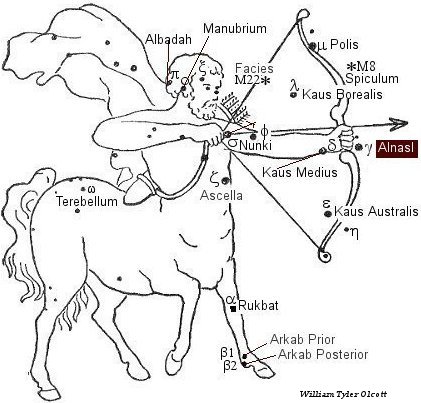| Fixed star: ALNASL | |
| Constellation: Gamma (γ) Sagittarius | |
| Longitude 1900: 29SAG52 | Longitude 2000: 01CAP16 |
| Declination 1900: -30.26′ | Declination 2000: -30.25′ |
| Right ascension: 18h 05m | Latitude: -06.59′ |
| Spectral class: K0 | Magnitude: 3.1 |
The history of the star: Alnasl
from p.357 of Star Names, Richard Hinckley Allen, 1889.
[A scanned copy can be viewed on this webpage
Gamma (γ) Sagittarius, Alnasl, is a yellow star marking the head of the Archer’s Arrow, companion nebula to Spiculum

{p.358} The Borgian globe termed it Al Wazl, the Junction, indicating the spot where the arrow, bow, and hand of the Archer meet.
This star, with delta (δ Kaus Medius) and epsilon (ε Kaus Australis) and with beta (β) of the Telescope (Telescopium), was the sieu (Chinese Moon Mansion) Ki, but in the worship of China the three were Feng Shi, the General of Wind.
In ancient Arabia the two small groups of stars now marking the head and the vane of the Archer’s arrow were of much note as relics of still earlier asterisms, as well as a lunar station. The westernmost of these, — gamma (this star Alnasl), delta (Kaus Medius), epsilon (Kaus Australis), and eta — were Al Na’am al Warid, the Going Ostriches; and the easternmost, — sigma (Nunki), zeta (Ascella), phi, chi, and tau, — Al Na’am al Sadirah, the Returning Ostriches, passing to and from the celestial river, the Milky Way, with the star lambda (Kaus Borealis) for their Keeper
Delta (Kaus Medius), gamma (this star Alnasl) and epsilon (Kaus Australis), was the Akkadian Sin-nun-tu, or Si-nu-nu-tum, “the Swallow”.
Star Names, Their Lore and Meaning, Richard Hinckley Allen, 1889].
The astrological influences of the constellation Sagittarius
The following are Ptolemy’s remarks: “The stars at the point of the arrow in Sagittarius have influence similar to that of Mars and the Moon: those on the bow, and at the grasp of the hand, act like Jupiter and Mars . . . those in the waist and in the back resemble Jupiter, and also Mercury moderately: those in the feet, Jupiter and Saturn.” … By the Kabalists Sagittarius is associated with the Hebrew letter Vau and the 6th Tarot Trump “The Lovers.” [Robson, p.60.]
The astrological influences of the constellation Sagittarius given by Manilius:
“As for the Archer, when the foremost portion of his cloak rises, he will give birth to hearts renowned in war and will conduct the conqueror, celebrating great triumphs in the sight of all, to his country’s citadels. Such a one will build high walls (moenia from Latin murus) one moment and pull them down the next. But if Fortune favours them too generously with success, the mark of her envy is to be seen on their faces, for she works cruel havoc upon their features. So was it that a dread warrior paid for his victories at the Trebia, Cannae, and the Lake, even before the hour of his retreat, with such disfigurement.” [Translator’s note: *Hanibal who lost an eye (Livy 22.2.11: Sagittarius is one-eyed; see p.103] [Manilius, Astronomica, 1st century AD, book 4, p.267]
“But they whose lot it is to be born under the Centaur of double form delight in yoking a team, in bringing a fiery horse to obey the pliant reins, in following herds which graze all over the grasslands, and in imposing a master on every kind of quadruped and taming them: they soften tigers, rid the lion of his fierceness, speak to the elephant and through speech adapt its huge bulk to human skills in a variety of displays. Indeed, in the stars of this constellation the human form is blended with a beast’s and placed above it; wherefore it has lordship over beasts. And because it carries a shaft poised on drawn bow, it imparts strength to limb and keenness to the intellect, swiftness of movement, and an indefatigable spirit.” [Manilius, Astronomica, 1st century AD, book 4, p.241.]
References:
Fixed Stars and Constellations in Astrology, Vivian E. Robson, 1923].